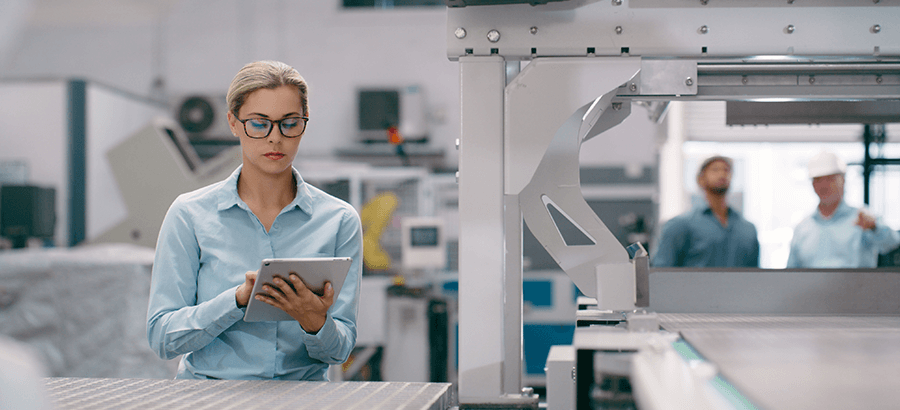Smart manufacturing is enabled by digital transformation. Fully implemented, it optimizes the manufacturing process through technology, like IIoT, artificial intelligence (AI), machine learning, cloud and mobile, driving cost efficiencies through every phase of the process.
However, few manufacturers have successfully implemented the changes necessary to achieve a complete transformation. Though technology is now more accessible than ever, companies still face various barriers to its adoption.
What is Smart Manufacturing?
To remain competitive today, manufacturing companies must focus on driving down costs and improving processes. Smart manufacturing is a state of manufacturing that is achieved by adopting Industry 4.0 technologies, data analytics and more to assist in and optimize manufacturing processes.
At the core of the smart factory is consistent data collection and real-time visibility, resulting in more transparency and better control. Smart technologies offer connectivity across departments, enabling data-driven decision making and driving efficiencies across the enterprise as the organization becomes aligned and interoperable.
Barriers to Adoption Impede Progress
To realize maximum profits in today’s volatile business landscape, companies must adapt to changing business environments and adopt digitalization if they wish to remain competitive. But, there are a number of barriers that manufacturers face that impede their progress:
1. Availability of Talent
The perception that automation is taking away manufacturing jobs is largely inaccurate. In fact, automation is creating jobs that we do not have enough skilled workers to fill. According to a study conducted by Korn Ferry, the skills gap could cost the world more than $8.5 trillion in unrealized revenue. The manufacturing sector sits firmly in the top three industries most at-risk.
Though manufacturing can be as high-tech as it comes, it is not perceived as a “sexy” or exciting career path. This makes it challenging to attract data analytics and AI expertise into the sector as new talent entering the workforce would prefer to work with companies at the forefront of tech innovation and implementation.
To overcome these barriers, companies need a solid talent strategy. Training should be the primary focus. By building knowledge and skills among existing employees, leaders invest in the future of their organization. Training is proven to be a high impact morale booster which promotes loyalty and therefore higher employee retention. Better collaboration between employees leads to improved efficiency.
Adopting and implementing new technology will help in attracting youth to join and pursue a career in manufacturing. In a recent study more than half of business professionals surveyed reported that an organization’s technology influences their decision to accept new positions.
2. Lack of Financial Resources
Large-scale legacy manufacturers often see smart transformation as being too costly or disruptive to execute. They fear losses from service interruptions or as a result of failed implementations. The added costs of hiring, training, infrastructure and revising established processes, can be sobering.
However, adopting new technologies such as IoT, Artificial Intelligence and Machine Learning means fewer errors due to decreased human intervention, better control and agility in operations, and granular visibility across the entire value chain of the business which results in decisive, informed and timely decision making and higher profitability. The ROI far outweighs the associated risks with continuing business as usual.
Government funding is a critical avenue that manufacturers can explore to fuel the adoption of smart manufacturing. For Canadian manufacturers, there are more than $32 billion in government grants and incentives, available.
3. Lack of Support from Leadership
Lack of skills aside, when leadership is unwilling to get behind the transformation, success is unlikely. According to a study published by the Society of Manufacturing Engineers (SME), one out of four companies lacks the vision and leadership to oversee and manage a successful implementation.
Leaders need to establish a learning culture and invest in training. They need to surround themselves with technology experts who acutely understand their business and know how to leverage technology that is necessary to drive successful business outcomes.
To ensure the success of your digital transformation initiatives, a committee of key stakeholders must be created that has clearly defined roles and KPIs to measure success. This helps in shared ownership and improved project governance.
Smart Manufacturing Journey: Considerations
When preparing for digital transformation to successfully align business and IT, manufacturers should consider these three building blocks:
1. Customer Experience
Your customers are the heart of your business. Traditionally, the world’s most successful companies are the ones that understand their customers best. Even with the advent of technology, this has not changed one bit.
In the early days of commerce, life moved at a slower pace. Today’s customers are more demanding and expect a more personalized approach. Companies that address these needs more precisely will gain their loyalty while those that can’t will lose favour.
Consider whether you have the visibility to define and control your customer’s experience across various touchpoints. Digital analytics support deeper customer insights and more precise segmentation, which helps companies better understand their audience through multiple touchpoints along the buying journey. A deeper understanding of the customer’s needs enables you to deliver expected value that drives loyalty, ultimately improving the bottom line.
2. Operational Processes
The digitalization of operational processes requires a complete and thorough understanding of every detail of your manufacturing operation. Once implemented, digitalization helps eliminate variability, automate repetitive processes, and remove manual processes typically fraught with human error. Automation supports employees in contributing at a much higher level, improving collaboration, boosting productivity, and providing the data necessary to drive better decision-making at the leadership level.
3. Business Model
Existing manufacturing business models are shifting. Because of that, this pillar requires the greatest effort to ensure a successful transformation. We are seeing entirely new business models emerge and we are rapidly becoming a subscription-and-service-based economy, in sharp contrast to past models, which were more focused on the product itself. Digitization, combined with more widespread and reliable internet access, has effectively reshaped organizational boundaries, accelerating timelines and requiring a more data-driven approach to stay competitive. Without digital capabilities like unified data and processes, analytics, business and IT integration, these opportunities would cease to exist.
Smart technology is essential to manufacturing business growth and profitability in 2020.







